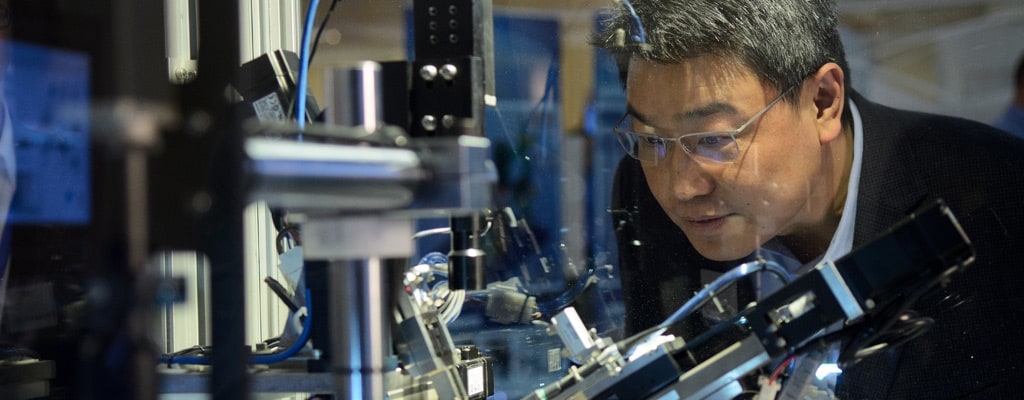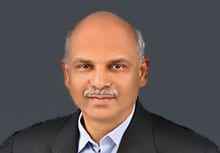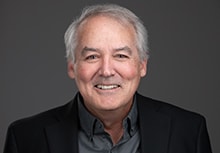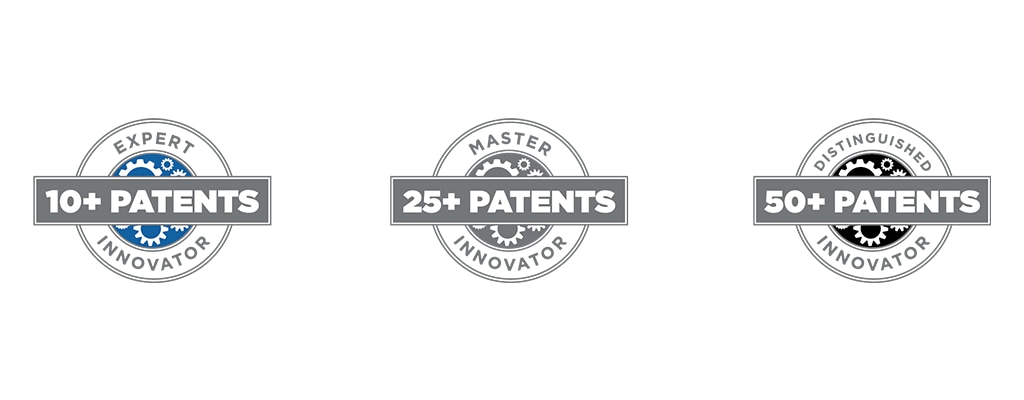
Driving Tech Innovation in Customer Industries
Our engineering leaders partner with customers worldwide to design next-generation technology. Together, we develop the robust, rugged solutions enabling fast, efficient, and reliable connectivity in data, power, signal, and wireless systems.
Our engineering leaders are committed to helping customers achieve business value through innovation in engineering, manufacturing, and materials. As the most technically accomplished members of our engineering community, our Fellows, Chief Technology Officers, and Subject-Matter Experts serve as mentors to colleagues and partners to customers. Their specialized capability and knowledge enables them to play a crucial role in leading the development of technology that is making the world safer, sustainable, productive, and connected.
Engineering Fellows

Bert Bergner
Fellow, Automotive
Bert is a subject-matter expert in automotive data connector design, RF signal integrity, and electromagnetic compatibility (EMC) engineering. He currently focuses on innovations and products for future in-vehicle data architectures.
Engineering Specialty
RF engineering, EMC, and simulations
High-speed signal integrity modelling
RF connector design
Automotive data transmission
Data connector tests and qualification
Focal Applications
Automotive data connectors
RF connector test methodologies
In-vehicle data architectures
Physical layer design automation
Ask Bert About
RF data transmission
Signal integrity and EMC engineering
Automotive data transmission protocols and connector test methods
Career Highlights
31 granted patents
OPEN Alliance Inc. Technical Committee 9 Chair

Isabell Buresch, PhD
Fellow, Automotive
Isabell specializes in evaluating and developing new material systems and coatings that make connector contacts and terminals more reliable and fit for future purpose. Her three decades of professional experience in surface and plating technology enables her to understand the intricacies of producing materials cost-efficiently using sustainable manufacturing processes.
Read Q&A with Isabell on innovation in automotive connectivity.
Specialty
Developing materials for contacts used in automobile systems
Analyzing production for more efficient, cost-effective processes
Ask Isabell about
Plating and joining technologies
Analyzing materials and surfaces
Base materials and metal substrates, material systems, and coatings
Achievements
24 patents
More than 60 articles authored

Markus Gutmann
Fellow, Industrial Automation & Electrification
Markus specializes in electro-mechanical switching solutions such as relays and contactors, with expertise in contact physics, contact kinetics, and contact metallurgy.
Specialty
Power switching
Manufacturing process technology
Developing innovative and efficient engineering teams
Focus
Industrial automation
New energy
Functional safety
Home and building automation
Smart switching solutions
Ask Markus about
Electromechanical relays and contactors
AC and DC switching
Safety applications (force guided relays)
Hybrid switching
New product development
Design for manufacturing

Vincent Huang
Fellow, Digital Data Networks
Vincent specializes in designing, testing and analyzing signal integrity (SI) performance of high-speed inter-connects.
Specialty
Signal integrity
High speed connector modeling
High speed connector simulation and post-processing
High speed connector testing and calibration
Connector SI tolerance analysis
Applications
Data communication
Electromagnetics
Waveguide
Passive components
Modeling and FEM simulation
Ask Vincent About
Signal integrity
CT scan and cross-section
S parameter and post-processing
Electromagnetic field
PCB SI
Dielectric WaveguideVector network analyzer
In-fixture calibration
Material, surface roughness

Sean Lewington
Fellow, Energy
Sean specializes in the development & design of new high-performance materials for harsh environments that make cable accessories & other insulating products more reliable, easier to install, longer lifetime & future proof. His many decades of professional experience in material science & technology enables him to understand the complexity of designing materials for cost effective & sustainable manufacturing.
Read Q&A with Sean on solving for innovation in energy performance.
Specialty
Designing anti-tracking/hydrophobic elastomeric & polymeric formulations for the power industry. Failure analysis & problem analysis methodology. Silicone rubber technology
Patents
6 patents
Ask Sean About
Silicone rubber technology
Design of materials for harsh environments
Sealants & adhesives
Failure analysis & problem solving

Rodney Martens
Fellow, Materials Sciences
Rod is a subject matter expert (SME) in electrical contact finishes, tribology, reliability, and currently focuses on open innovation research with universities and research institutes to meet TE’s current and future technology needs.
Engineering Specialty
Electrical contacts
Reliability and Failure Analysis
Carbon nanotubes and graphene
University and Research Institute Collaboration
Focal Applications
Tribology and corrosion of contact finishes
Reliability
Open Innovation
Webinars with and Articles Authored by Rodney
“Using Graphene to Improve Electrical Contacts”
Over 50 publications in journals and technical conferences
Career Highlights
18 US patents, 1 National Science Foundation grant
Director, IEEE Intensive Course on Electrical Contacts

Matt McAlonis
Fellow, Aerospace
Matt specializes in solving for power and signal connectivity, especially when it involves high-speed connectors, PCB interconnects, compliant pin technology, and VME/VPX system solutions.
Read Q&A with Matt on solving for connectivity in aerospace.
Specialty
Rugged connector designs for aerospace
Applications
Spacecraft (manned and unmanned)
Aircraft (manned and unmanned)
Ask Matt about
Connector solutions for VPX architecture
Read Articles Authored by Matt
Imagining the Future of Flight
Interviews with Matt
Technical Path for eVTOL Technologies (Part 1)

Bernard McDermott
Fellow, Medical
Bernard specializes in the design and development of interventional medical devices and device components at TE. He works closely with customers to provide high performance, cost-effective, novel, and manufacturable solutions from conception to production. A subject-matter expert in structural heart therapies and devices, Bernard also has extensive experience in electrophysiology, cardiovascular, neurovascular, peripheral and endoscopic devices.
Bernard is a member of the advanced technology group, whose key role is to take a long-term view of the future of medical device developments to identify and develop technologies that our customers will need in the coming years. In addition to nearly two decades of experience in medical device innovation and rapid prototyping groups, Bernard also has an extensive experience in other areas, including high-volume electronic device manufacturing and thermal design.
Engineering Speciality
Braided, hypotube or hybrid-based device design
Laser cut hypotube component design
Device simulation
Sensor integration
Design for manufacturing
Novel additive manufacturing processes
Focal applications
Smart devices
Next generation devices and constructions
Novel automated manufacturing processes
Ask Bernard about
Structural heart therapies and current devices
Future trends in interventional therapies
Component and device design
Design for manufacturing

Robert Moore
Fellow, Aerospace, Defense, & Marine
Robert specializes in solving and providing data and power solutions in the harsh
environments experienced in space, commercial and military aerospace, land, and
marine applications.
Specialty
High-speed data communications over copper, EWIS, and EMI mitigation.
Focus
Aerospace including spacecraft, manned and unmanned flight, ground systems, and copper solutions
Ask Robert About
High-speed communications, EMI mitigation, and EWIS.
Articles by Robert (links direct to another website)
"What EWIS Is and Why It Matters for Wiring Aircraft" - Aerospace Tech Review
"Commercial Protocols and Aerospace Cabling" - Assembly Magazine

Chad Morgan
Fellow, Digital Data Networks
Chad specializes in analyzing and designing high-speed, high-density components, as well as in developing signal integrity modeling, simulation, and measurement methods for characterizing digital and RF components. He is also focused on characterizing advanced conductor and dielectric materials electrically for high-speed signal transmission.
Read Q&A with Chad on solving for connectivity in data centers.
Specialty
Electromagnetic interconnect modeling (FEA, TLM)
Full system simulation (SPICE, linear, convolution)
Component and system verification testing (TDR, VNA, BERT)
High-speed network analyzer measurement & de-embedding
High-speed right-angle and direct-plug orthogonal designs
Low-skew geometry modeling & novel solutions
Applications
Data center architectures (routers & switches)
Server architectures & disaggregation
Wireless backbone digital applications
High-speed, high-density digital component modeling
High-speed, equalized system simulation
Metal & dielectric electrical characterization at high frequency
External 28-112 Gbps cable assemblies (QSFP, OSFP, QSFP-DD)
Internal low-loss cable assemblies (Sliver cable assemblies)
Cabled backplane solutions (cabled STRADA Whisper connectors)
Ask Chad about
Choosing tools and methods for predicting performance
Achieving low insertion loss and crosstalk to 50 GHz
Removing unwanted resonances from components
Measuring high-frequency material characteristics
Selecting materials for high-speed

Marjorie Myers
Fellow, Automotive
Marjorie specializes in connector contact material, physics, plating, treatments, and performance to analyze, develop, evaluate, and introduce new advanced contact approaches and processes for TE products.
Engineering Specialty
Contact physics/function – electrical and mechanical
Material and performance analysis
Plating process
Focal Applications
Connection performance analysis and development (platings, treatments, finish systems)
Training development
Advanced automotive development
Professional Accomplishments
50+ publications, both internal and external
13 patents granted

Anil Kumar Ramsesh, PhD
Fellow, Industrial Automation & Electrification
Anil is a multidisciplinary problem solver with experience in applied research, technology development, and knowledge-based lean product development. His three decades of experience in research and product development enables him to understand the complex multidisciplinary product designs, customer needs, and provide solution. He is a passionate mentor and teacher and well-connected with universities, which enables him to support TE’s talent and technology needs.
Areas of Engineering Specialty
System design: Electro-mechanical, electrical, and electronics
Design of mechanisms, drives, signal conditioning, power supply, modelling, design for EMI / EMC and testing
Sensor design, selection and fusion
Data analysis and interpretation. AI and ML algorithm for prediction
Testing and characterization: Electroanalytical methods (Voltammetry, Amperometry, Electrical Impedance Spectroscopy, Tafel plots, etc.)
Focal Applications
Smart devices, IOT, and IIOT
Sustainable processes and materials
Drive Innovation, develop and mentor key technical talent
Ask Anil About
End-to-end multi physics system modelling and problem-solving
Sensor fusion and IOT system
Electrochemical and Tribological test methods
Design for EMI, EMC, and ESD
Design for high temperature, pressure, and harsh environment applications
Career Highlights
25 Publications
8 patents granted
Co-author, ‘Micro Grid Architectures & Maintenance’, LAP LAMBERT Academic Publications GmbH & Co. KG, Germany. ISBN 978-3-659-27797-9, 2012

Josef Sinder
Fellow, Transportation
Josef specializes in process improvement and process innovation in stamping, plating, molding and assembly.
Read Q&A with Josef on solving for improvements in manufacturing processes.
Ask Josef about
Manufacturing and automation
Stamping dies
Injection molds
Digital factory

Bill Weeks
Fellow, Corporate Technology
Bill helps customers solve for high-speed, ruggedized, small form factor and low-cost optical transceivers.
Read Q&A with Bill on solving for connectivity in technology.
Specialty
End-to-end networking solutions for high speed communications
Applications
Aerospace systems
Transportation systems
Medical devices
Fiber optic sensing
Ask Bill about
Fiber optics
High speed communications
Networking - all types

Emily Zhang
Fellow, Global Operations
Emily specializes in automation manufacturing technologies and AI innovations and solutions to serve TE’s manufacturing processes.
Areas of Engineering Specialty
Automation Manufacturing Technologies
AI Technologies
Robotics and Machine Vision
Focal Applications
Process Automation
AI & Machine Vision
AI Process Control and Optimization
Robotics
Ask Emily About
Automation
AI Applications in Manufacturing
Robotics and Machine Vision
Career Highlights
216 patents granted in 14 countries
24+ papers published in TE internal conferences and external
journals/conferences
Chief Technology Officers

Davy Brown
VP & CTO, Transportation Solutions
Davy Brown serves as the Vice President and Chief Technology Officer for TE Connectivity’s Transportation Solutions segment since October 2024.
As the technical leader of the Transportation Solutions segment, Davy is responsible for the strategic direction of global engineering and product research and innovation within the Global Automotive, Industrial & Commercial Transportation, Sensors, and Global Application Tooling business units.
Davy joined TE in 2013 as Vice President and Chief Technology Officer of the Telecom and Wireless businesses and continued in that role after the merger and creation of Broadband Network Solutions (BNS). He then served as Senior Vice President, Research and Development of CommScope’s Connectivity Solutions business after its acquisition of BNS before returning to TE in 2017. From 2017 until 2024, Davy served as the Vice President and Chief Technology Officer for TE Connectivity’s Industrial Solutions segment.
After beginning his career at British Telecom Research Labs, he has held senior technology leadership and executive roles in various technology companies spanning the semiconductor, software, consumer electronics and telecommunications industries. He also co-founded and served as CTO of Trinity Convergence, a multimedia communications company.
Davy holds a Bachelor’s degree in Computer Science from the University of Newcastle Upon Tyne, UK.
Articles Authored by Davy
The Electrification of Everything
Interviews with Davy
Accelerating the Electrification Everywhere Evolution

Phil Gilchrist
VP & Chief Transformation Officer, Artificial Intelligence & Sustainable Materials
Phil Gilchrist has served as the Vice President and Chief Transformation Officer, Artificial Intelligence & Sustainable Materials since March 2024.
Previously, he served as the chief technical officer for the Communications Solutions segment, responsible for the strategic direction of global engineering and innovation, product research, engineering talent and digital process development within these business units: Data & Devices and Appliances.
Phil first joined TE in 2011 as Vice President and Chief Technology Officer of the Enterprise business unit, moving on to be the CTO of TE’s Datacom business unit. He then served as General Manager of Optics and CTO of Data and Devices until becoming the CTO for the Communications Solutions Segment.
After beginning his career as the Co-Founder of a technology start-up, Phil held numerous senior technology leadership and executive roles at Motorola from 1999-2011 focused on software, chipset and platform product development.
Phil holds a Bachelor’s degree (Hons) in Computer Science from the University of Stirling, Scotland.
Article by Phil
The Promise of Advanced Materials
Interviews with Phil
Developing Advanced Materials
Closing the AI Knowledge Gap

Travis Dahlstrom
VP & CTO, Medical
Travis is a technical leader with 15 years of engineering, operations, lean, supply, and project management experience. He leads a global technology team that partners with customers to develop critical medical component and device solutions that save lives.
Areas of Engineering Specialty
New Product Development
NPD Processes
PMO
Lean Manufacturing
Quality
Focal Applications
Medical Components and Devices
Ask Travis About
New Product Development
Lean Manufacturing
Project Management
Design for Manufacturing

Jamie Janawitz
VP & CTO, Aerospace, Defense, & Marine
Jamie leads a global team that specializes in the development and commercialization of next-gen power and signal connectivity solutions across the electrical, optical, and RF domains.
Specialty
Executing and accelerating product roadmaps to deliver differentiated value
Applications
Spacecraft
Aircraft
Defense (Land & Marine)
Ask Jamie about
Lean product development
The future of air & space travel

Rolf Jetter
VP & CTO, Automotive Europe
Rolf leads TE´s automotive team in Europe. His team partners with automobile manufacturers and suppliers in the European region to serve the future needs for all customers.
Areas of Engineering Specialty
New Product Development
New Technology for Automotive Applications
Metals and Surfaces for Harsh Environments
Road mapping and Skill/Talent Development
Focal Applications
E-Mobilty
Core Terminal and Connector Products
Digital Service
Ask Rolf About
New Innovations on Core Products
Transformation to E-Mobilty
Digital Transformation and New Digital Services for our Customers
Sustainable Products
Simulation
Harness Automation and New Zonal Harness Architectures
Connector and Terminal Design for Harsh Automotive Environment
Skill and Talent Development

Mihran Kireccioglu
VP & CTO, Automotive Asia Pacific
As VP & CTO of Automotive Asia-Pacific in TE Connectivity, which includes China, Korea, Japan & South of Asia, Mihran leads a cross-regional engineering team who develops connectivity solutions for Automotive with a product & value driven approach and delivering cost, quality, and time to market requirements of a highly dynamic and fast-growing Asia Pacific region.
Areas of Engineering Specialty
Complete Vehicle Development
New Product Development and Innovation
Engineering Project Management
Product & Technology Road mapping
Focal Applications
Signal and Power Connectivity
E-mobility
Data Connectivity
Ask Me About
Vehicle Development and Project Management Processes
Value Analysis / Value Engineering / Design To Cost / Benchmarking
Engineering Strategy & Resource Management
Cross-Cultural Collaboration
Product Business Plans
Articles
Rapid Innovation Puts Pressure on EV Battery Connectors (Connector Supplier)

Nick Liu
CTO, Application Tooling
Nick leads a global team that develops the application tooling solutions providing reliable and precision terminations to enable connectivity solutions across various
industries.
Areas of Engineering Specialty
Product and Process Development Engineering
Program Management
System Architecture and Platform Development Engineering
Lean 6 Sigma
Focal Applications
Crimping and Press Fit Technologies
Magnet Wire and Pin Insertions
Ask Nick About
Terminal and Connector Design
High Voltage and Data Connectivity
Cable Assembly and Harness
PCBA & Sensor Packaging
System Architecture

Alex Megej
VP & CTO, Connected Living Solutions
Alex leads a global team focused on solving for reliable connectivity in harsh environments.
Read Q&A with Alex on enabling innovation in industrial connectivity.
Specialty
Wired and wireless connectivity
Sensor systems
Ask Alex about
System design: Mechanics, electronics, firmware
Technology and strategy development
R&D effectiveness
Articles and Books Authored by Alex
The Growing Role of Cobots in Factory Automation
Integrated Microwave Sensors for Cavity-length Measurement in Machine Engineering
40+- articles and patents (see bibliography)
Interview with Alex
Designing Factory Cobots

Lisa Miller
VP & CTO, Industrial & Commercial Transportation
Lisa is a decisive and effective transportation industry executive with 29+ years of experience in product engineering and design, manufacturing, sales, business development and organizational management. She is a proven cross-functional leader in innovating and developing products and manufacturing solutions respecting customer demands in quality and cost, while securing internal objectives in overall business strategy. Lisa currently leads a global team focused on providing reliable connectivity products designed to withstand harsh environmental conditions for on- and off-highway vehicles and recreational transportation.
Specialty
Product technology strategy
Inspiring & enabling innovation
New product development execution excellence
Developing high performing teams
Design for manufacturing and assembly
Applications
Industrial and commercial transportation
E-Mobility
Data connectivity
Electromechanics
Terminals and connectors
Cable assembly systems
Ask Lisa About
Advanced driver-assistance systems (ADAS)
New product development
Product technology roadmaps
Developing people and teams
Minimum technical solutions
Design for sustainability
Customer focus
Articles Authored by Lisa
The future of autonomy for on-highway vehicles
(connectortips.com)

Ruediger Ostermann
VP & CTO, Global Automotive
Ruediger Ostermann is Vice President and Chief Technology Officer for TE Connectivity's Global Automotive Engineering business. His experience is built on a lifelong career in the field of T&C, junction boxes, and wiring harnesses in different companies and regions. His areas of specialty include vehicle electrical architecture and applications as well as engineering strategy and management. Ruediger joined TE in 2015 and has held various roles within the organization rising in the ranks from Senior Engineering Manager to most recently CTO of Asia Pacific, leading the Asia Pacific automotive engineering business with teams in China, Korea and Japan. Prior to joining TE, Ruediger held roles at SEWS-CE, Lear Corporation, Stocko GmbH & Co KG and EDM Engineering GmbH. Ruediger holds a degree in Mechanical Engineering from FH Muenster, Germany.
Areas of Engineering Specialty
Vehicle Electrical Architecture and applications.
Engineering Strategy and Management
Focal Applications
T&C core
eMobility
Data Connectivity
Articles Authored by Rudi
Software-Defined Vehicles Allow Upgrades with Ease
Interviews with Rudi
Designing Software-Defined Vehicles

Jeremy Patterson
VP & CTO, Americas Automotive
Jeremy leads TE’s automotive team in the Americas. His team partners with automobile manufacturers and suppliers in the Americas regions to serve the technology needs for all customers.
Areas of Engineering Specialty
New Product Development
Innovation
Talent Development
Strategy Development
E-Mobility Product and Technologies
Focal Applications
E-Mobility Products – High Power Terminal and Connectors, Charging Solutions, Battery Connectivity
Low Voltage Terminal, Connector, and Header Products
Ask Me About
New Product Development
Innovation Process and Cross-Functional Collaboration
Technology Roadmaps & Execution
Automotive Technologies and Market Trends
E-Mobility
Career Highlights
27 patents awarded

Thomas J. Schoepf
VP & CTO, Industrial Automation & Electrification
Thomas leads a global team that develops innovative connectivity solutions for industrial technologies.
Specialty
End-to-end customer-centric innovation
Research and development
Ask Thomas about
Industrial networks and systems
Industrial systems design
Technology and strategy development
Articles Authored by Thomas
Fueling the Future of Renewable Energy
Interview with Thomas
Understanding Future-State Renewable Energy

Corneliu Tobescu
VP & CTO, Sensors
Corneliu is a dynamic and results-driven executive in the sensor technology industry, bringing over two decades of experience in product development, engineering, and organizational leadership. Since March 2024, Corneliu has served as the VP & CTO of TE's Sensors business unit, overseeing all aspects of sensor engineering.
Corneliu joined the Sensors business unit in February 2022, as the Sr. Director for Central Technology Development. In this role, he led an international engineering organization focused on the development of MEMS sensing components for pressure, temperature, force, and vibration applications across industrial, medical, and automotive markets. He also spearheaded ASIC development and IoT sensor wireless module innovations, covering both hardware and software.
Before joining TE, Corneliu successfully led and expanded R&D organizations in the semiconductor industry, specializing in CMOS image sensors at AMS OSRAM, automotive speed and positioning sensors at NXP, and display driver ICs at Philips Semiconductors. Additionally, Corneliu was the COO of Berlinger AG, a Swiss company known for developing and manufacturing IoT-like temperature monitoring systems for vaccine storage and transportation, which included real-time data management and analysis software. Corneliu holds a Master’s degree in Electronics from the Swiss Federal Institute of Technology in Zurich and an Executive MBA from the Zurich School of Economics.
Specialty
• Leading Global Engineering Organizations – developing high performance teams
• Product technology strategy, roadmapping
• Enabling Innovation
• New Product Development Execution Excellence
• MEMS Sensing and Semiconductor Technology
• Automotive, Industrial and Medical Sensors
• ASIC Development
• IoT Sensor Solutions, Data Management and Analysis Solutions
• CMOS Image Sensors
• Display Driver ICs
• Operational Management
• Sensors and Electronics Design for manufacturing and assembly
Applications
• Transportation Sensing Solutions
• Automotive Safety Applications
• E-Mobility
• Condition Monitoring
• Motion Control
• Cobots & Robotics
• Semiconductors
• Medical Pumps
• Minimally Invasive
• Respiratory Care
Ask Corneliu about
• Sensing Technologies and IOT
• Semiconductors Technologies
• Driving Innovation and Technology Development
• New Product Development
• Product Technology Roadmaps
• Building and Leading Global Engineering Organizations
Articles by Corneliu
IoT Threat Protection Is a Shared Ecosystem Responsibility

Mike Tryson
VP & CTO, Digital Data Networks
Mike leads the global data and devices engineering team, partnering with the data centers around the world to develop their interconnect solutions and architectures.
Specialty
Engineering strategy and execution excellence
System engineering, optics, and high-speed smart materials Micro-electronics
Applications
High-speed data communications
Optical transportation
Data center architectures
Ask Mike about
System design and architecture
Optics science
Technology roadmaps
Engineering program management and best practices
Read Articles Authored by Mike
Machine Learning in Data Center Architectures
How High Speed Connectivity is Enabling IoT
Engineering Subject-Matter Experts
Aerospace SMEs
-
Karl Kitts
Senior Manager, Development Engineering
-
Robert Moore
Global Specialist & Principal Engineer
-
Martin Cullen
Senior Business Development Manager
-
Mark Benton
Mark Benton, Senior Principal Development Engineer
Data Center SMEs
-
Brian Costello
Business Development Manager
-
Lieven Decrock
Principal Electrical Engineer
-
Nathan Tracy
Principal R&D/Product Development Engineer
Defense & Military SMEs
-
Michael Walmsley
Global Product Manager, Aerospace and Defense
-
Franck Kolczak
Franck Kolczak, Business Development, Defense
Energy & Utilities SMEs
-
Christoph Lederle PhD
Sr. Dir. Product Management
-
Luis Puigcerver
Senior Product Manager, WAP
-
Alexander Eigne
High Voltage Cable Accessories Product Manager
-
Carlos Riva
High Voltage Cable Accessories Product Manager
-
Laura Hiller
Wildlife and Assets Protection Product Design Engineer
Connected Living Electronics SMEs
-
Jonathan Catchpole
System Architect, Intelligent Buildings
Industrial Technology SMEs
-
Mark Zitto
Product Engineer
-
Matt Mostoller
Manager, Development Engineering
Medical SMEs
-
Richa Anand, PhD
Product Manager, Surgical
-
Troy Brown
Advanced Development Engineer
-
Katie Devin
Product Manager, Metal Shafts, Hypotubes & Needles
-
Sheila Garza
Senior Manager, Customer Service
-
Charlie Holtan
Development Engineer
-
Steve Hsu
Engineer Manager, Polymer Tubing
-
Makiya Kimura
Manager, Product Development Engineering
-
Marie Ottum
Sr Principal Engineer, Advanced Development
-
Jamal Rezayee
Principal R&D and Product Development Engineer
-
Tommy Thao
Field Application Engineer, Metals
Subsea Production SME
-
Jeremy Calac
Product Manager, Optic & Signal Systems
Transportation SMEs
-
Mark Brubaker
Product Manager, Data Connectivity, Global
-
Paul Webb
Global Product Manager, Autosport
-
Clint Schlosser
Manager, Product Management
Transportation SMEs - Commercial & Industrial
-
Daniel Domke
Product Manager, E-Mobility Solutions
-
Eric Hoffmann
Product Management Lead, E-mobility
-
Kimmy Jin
Product Manager, E-mobility Solutions
-
Drew Reetz
Product Manager, E-mobility Solutions
Innovation Badge Program
Innovation Badge Program
Recognizing Engineering Milestones
Our 8,000 engineers innovate every day and one way they showcase their ingenuity is through the patents they obtain during their time at TE Connectivity. Our Innovation Badge Program recognizes our global innovators for their outstanding ability to generate intellectual property (IP) for TE. Since 2010, TE has recognized innovators who have reached established milestones in generating IP through identifiable physical and digital badges.

See More about Innovation at TE




